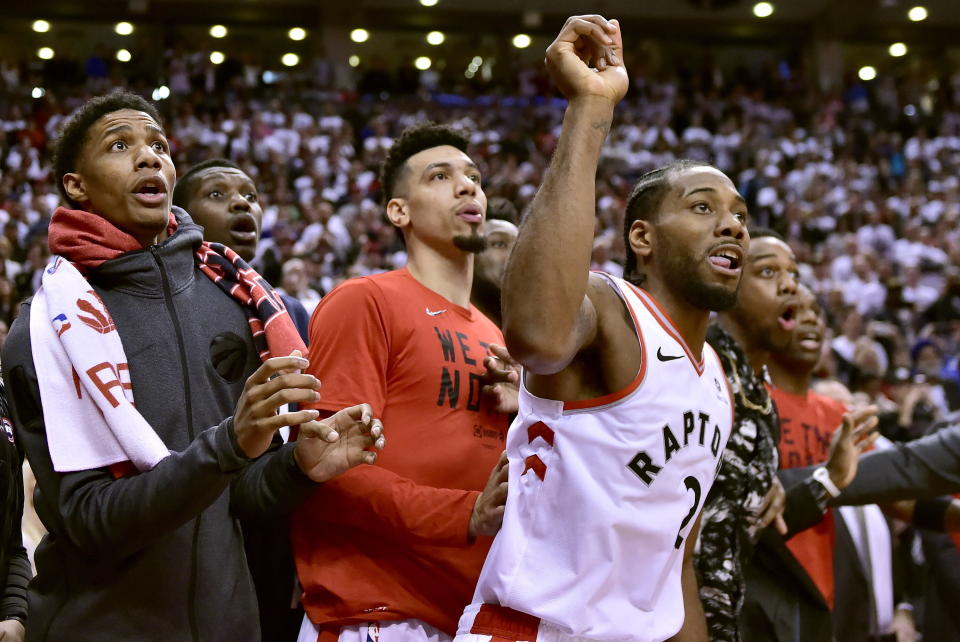Kawhi Leonard’s Game 7 buzzer-beater did more than just save the Raptors — it altered the NBA’s future
TORONTO — Before unfurling the shot that eradicated every shot before it Sunday night, Kawhi Leonard took one last, long stride to create the distance he needed to separate himself from Joel Embiid’s towering 7-foot frame before turning and fading backward from 20 feet.
In the three seconds that time stopped for nearly 20,000 people, you could feel the span of 18 years, when Vince Carter missed the same jumper against the same team in the same situation, Game 7 of the Eastern Conference semifinals, in almost the same spot, the same way. Like Carter, Leonard faded and fell out of bounds.
When the ball bounced off the front of the rim and the buzzer sounded, Leonard and Embiid stood beside each other, melding into a crowd of onlookers that stared as so many fates hung in the balance: the Sixers, who made two blockbuster trades for the right to show Jimmy Butler and Tobias Harris why they should be the ones paying them; Leonard and the Raptors, who will have their free-agency conversation this July; and the teammates and staffers who will feel the ripples of those decisions.
The ball bounced off the front of the rim again, and Leonard crouched to the floor, almost as though he was trying to will the ball to drop into the rim. It was an impossible shot then. It’s an impossible shot today. But Leonard put the Raptors on the right side of impossible. Like a grain of sand, the ball hit the back rim twice and dropped through the net. Leonard leapfrogged back up, falling into his teammates’ arms, celebrating an Eastern Conference finals berth with a 92-90 victory, while a heartbroken Embiid crumbled into the arms of mentor-turned-opponent Marc Gasol.

“As painful as it feels now, it’ll help him,” Sixers coach Brett Brown said. “It’ll help shape his career. It’ll help give him greater clarity of what this time of the year represents. All the stuff that has to accrue over many months that will one day lead to the ability to one day be a champion. It’s hard. It’s hard to be the last man standing.”
Embiid was the recipient of another kind of playoff torch, one Leonard knows all too well: a summer of regret. Leonard’s shot didn’t only eradicate the Raptors’ tortured playoff past — it turned his own, both new and old, into ancient history.
Six years ago, Leonard lined up at the free-throw line for two shots that could have sealed a championship for the San Antonio Spurs. But with a two-point lead and 19.4 seconds left on the clock, he split them, giving Ray Allen and the Miami Heat the opening they needed to tie the game and complete one of the most improbable comebacks in Finals history in overtime.
Sunday night, Leonard found himself in the same situation: at the free-throw line, with 10.8 seconds remaining and a one-point lead. But he canned the first free throw and clanked the front iron on the second. The Sixers corralled the rebound, and, to make matters worse, Leonard crashed the boards instead of getting back on defense, allowing Jimmy Butler to surge up the floor for a game-tying layup.
Public perception paints Leonard as emotionless, almost robotic, an animatronic and even-keeled curation of perfect basketball traits. But he was, in his words, “very mad” that he missed the free throw and that he didn’t get back in transition defense. “After that,” he continued, “I was just like, whatever play [coach Nick Nurse] drew up, I'm about to get to my spot and shoot it. Shoot it with confidence. Things happen for a reason, I guess, and it went down.”
What’s impressive about Leonard isn’t that he’s emotionless. It’s that he filters emotion like he does information: productively and quickly. This is, after all, the guy who told reporters he was looking forward to returning to San Antonio — where he was inevitably going to be booed every time he touched the ball — because the experience might give him something new to learn.
When Leonard walked up to the podium after hitting the first Game 7 buzzer-beater in NBA history, the man who usually gives up the bare minimum offered some rare insight into how the wheels turn behind the mind of the best player in the conference — and maybe the world.
“We ran a similar play during the Magic series, and I ended up just catching and shooting the ball. It was probably like three seconds,” Leonard said. “So I just remembered that moment and knowing I had time, at least, to pump-fake or take a dribble. So [Nurse] drew up the play again tonight and there was four seconds left. Remembering that moment, I knew I had some time to try to get some space rather than just catch-and-shoot the ball. I ended up catching it and just trying to get to a space so I could get a shot off. Embiid was guarding me. He's taller, longer than me. So I ended up finding a spot that I like, that I work on. Then I just knew I had to shoot it high. A couple possessions before that, I had the same kind of shot from three and ended up coming short. I just thought I had to put it up even higher than that. Ended up getting a soft touch and going in.”
The rest is history. From regret to self-regulation to redemption, in the span of 10.8 seconds.
More from Yahoo Sports:


